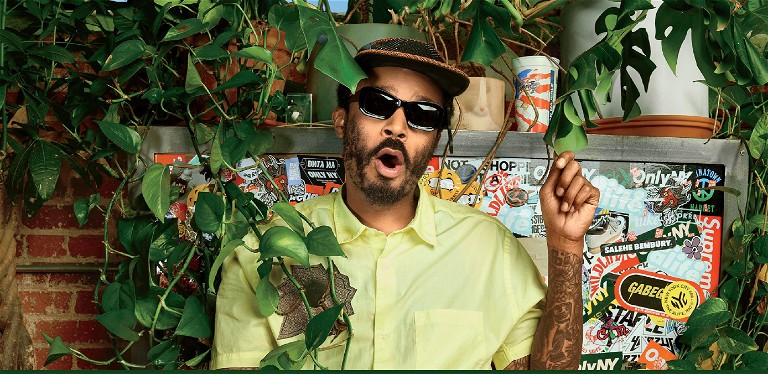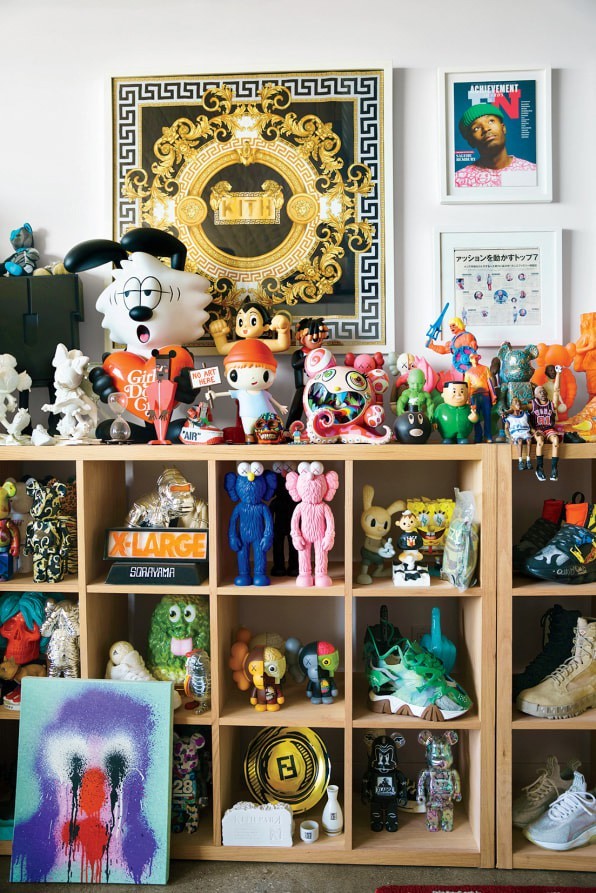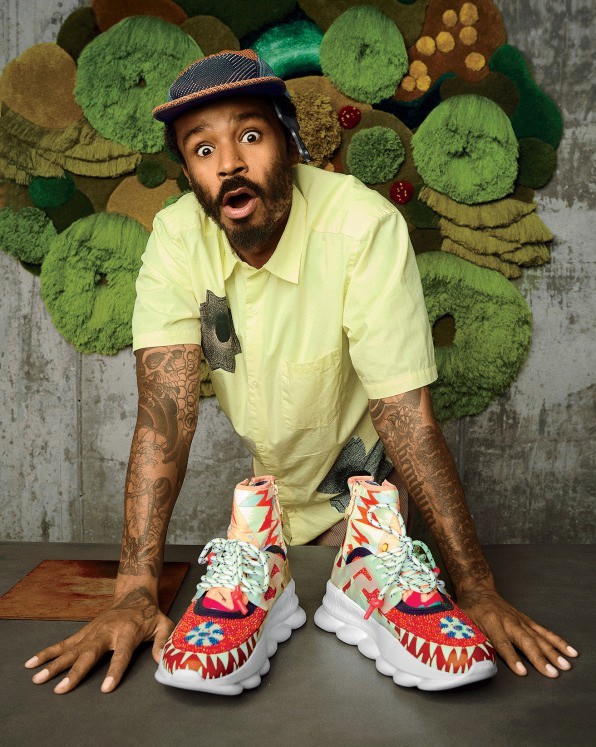Why everyone in the $127 billion sneaker business wants to work with Salehe Bembury
BY MARK WILSON

It’s impossible to walk with Salehe Bembury and not stare at everyone’s feet.
The asphalt is stick-to-your-soles hot as Bembury, one of the most famous shoe designers on the planet, threads his way through the stalls of Pasadena, California’s legendary Rose Bowl Flea Market where, once a month for the last 50 years, designers like Christian Louboutin have gone elbowto-elbow with bargain hunters in search of unique treasures. The thousands of stalls filled with millions of knickknacks feel, in many ways, more oppressive than the blacktop, a seemingly endless array of faded Yu-Ghi-Oh tees and frayed Lakers jerseys, mid-century dining tables, and 35 mm-era Olympus point-and-shoots. But as we walk, a quick glance beneath the card tables reveals a whole other world, a tacit language gestured through our footwear.
Gen Z goths and Gen X home-improvement types rock the same black Vans Old Skools (though in the latter case, they’re bruised and ripped at the seams). The millennialswith-a-job wear stock Air Max 90s and Yeezy 350s. Then there are the hypebeasts who have chosen something quirkier to signal their elevated taste. When we turn a corner, three young men are waiting—wearing, respectively, mintcondition Midnight Navy Nike Dunks, Off-White x Jordan 5 SP “Sails,” and turquoise New Balance “Water Be the Guide” sneakers—and that’s when I realize that this group isn’t here by coincidence.
I’m a professional design writer, and I can’t tell you who designed my car, my couch, my refrigerator, my home. But I do know that the 6-foot-3 man standing next to me created those shaggy-textured New Balances, as does everyone else in that group. They can also tell you that it’s the second most sought-after color combination of his reinterpretation of New Balance’s 2002R shoe, meaning it’ll run you about $300 on a resale site. The most coveted version—Bembury’s Peace Be the Journey, which captures the golden hues of Antelope Canyon—can fetch more than double that.
Bembury’s fans are the freshest dorks the eye has ever seen. They don’t ask, “Are you Salehe Bembury?!?” before sheepishly requesting a selfie because they already know— recognizing Bembury from his Instagram posts, where he’s grown his follower count from virtually a standing start to more than 541,000 in the past two years, and confirming his celebrity by the shoes he’s wearing. Not just his impossibleto-get Crocs Pollex, but Pollex in the black “Sasquatch” colorway, which at this moment, haven’t yet shipped to the public. (Another tell: Bembury is conspicuously holding a just-purchased, single size 22 high-top that was made for the one person who could wear it, Shaquille O’Neal.)
Bembury, who carries himself with a contemplative presence, perks up, smiles, and leans in for some photos. Only afterward does he confess to me how uncomfortable he is with his new recognizability, how the only time strangers usually come up to you to talk is when they’re drunk on Halloween.
“I low-key became famous during COVID. So it went from, like, no one knows who I was to, oh, lockdown is over, suddenly we can go outside again. And everyone’s like, ‘Salehe?’” Bembury says. “I’ve got a good poker face, but it just throws me because I’m not that far removed from being that person. I remember being at the Rose Bowl four or five years ago and seeing Jeremy Scott!”
Shoes are the only piece of apparel that keep their shape after you take them off—meaning sneakers are as much sculptures as they are clothing. Yet, as far as art goes, they’re relatively affordable, which is why sneakers have become such a democratizing cultural force of our era, driving a $127 billion global market. Constructed of high-performance materials that stretch around and support various parts of the foot with pinpoint accuracy, sneakers are also featherweight marvels of biomechanical physics. Whereas creatives of the 1960s dreamed of designing a chair, and in the 1990s and 2000s they strove to mold plastic and aluminum around consumer electronics, today they aspire to stamp their name on a sneaker. Bembury is the perfect embodiment of this new kind of celebrity industrial designer, as fluent in fashion as function.
To understand the significance of Bembury’s contributions to footwear, you need to understand how sneakers are made. The bottom of the shoe is generally created from molded foam, for bounce, while the top is crafted from one of countless types of stitched and woven textiles (necessary to conform to your rounded foot). To change a colorway— altering the hue of the fabric upper—is simple for most shoe companies. But to change a silhouette requires going back to the last (the technical term for a foot form) to fashion the upper, while developing new molds for the bottom “outsole.” This is a major undertaking within industrial production because it requires retooling an assembly line and making a four-to-five-figure investment for each individual size that’s offered, simply to build injection molds for each size of outsole. From a financial standpoint, the lazier a sneaker collab, the better for a company—especially because most sneaker collaborators are either fashion designers or celebrities: people who don’t actually know how to build a shoe in the first place.
Bembury has created new molds at Crocs and New Balance over the past few years, and his slate of 2022 collaborations includes other iconic or cult brands such as Vans and Brandblack. But Bembury’s ambition extends far beyond creating new silhouettes across the industry. While most industrial designers are inept when it comes to fashion (consider that Apple, the preeminent industrial-design firm, makes just one fashion-oriented product, the Apple Watch), Bembury is not, allowing him to turn the model of success inside out. Sneakers aren’t his reward for fame in another field but rather his foundation, his muse—from which he’s growing into outdoor gear, home goods, and high fashion. (The first work from his partnership with Moncler is slated for 2023.) “I think I’m always gonna introduce myself as a footwear designer, no matter what I make,” Bembury tells me, reflecting the primacy that sneakers hold in popular culture. “Yeah, there’s something nice about that.”
Slipping on Bembury’s Crocs Pollex is a strange sensation. The undulating, ridged mules, which he designed for the $2 billion–plus footwear brand and initially released in December 2021, feel less like wearing brand-new shoes made overseas than a fresh pair of feet shipped from another planet. The aesthetic invites the world to comment on your feet—and boy, do they comment.
Only when you walk through something forgiving—sand, water, a high-pile carpet—do you realize the degree to which Bembury has put his signature on the shoe. The Pollex’s impression left in your wake clearly resembles a thumbprint. Bembury’s, to be precise, for those in the know. So you’re not just making your own mark on the trails you blaze but you’re spreading Bembury’s. (Technically, the design is a combination of three of his fingertips, so you cannot hold up a Pollex to unlock Bembury’s iPhone.)

At the same time, the form of the Pollex contains its function. Bembury beefed up the Crocs’s treads to offer a surprising amount of grip, and reinforced its heel and toe with rubber to stand up better to wear. He chose a nylon strap for durability, and redesigned its connection joints like vintage military clips, a nod to the Pollex’s utilitarian function. He even tweaked the ventilation holes to ensure the wearer’s three smaller toes remain covered in the shoe. He went so far as to draw a diagram of the human foot to convince Crocs of this necessity, demonstrating that people’s first two toes are generally the most attractive, whereas the other three are often bent and unkempt.
“I don’t want to design this beautiful thing, and then the most raisin pinky toes are popping out of one of the holes,” he says, laughing, before noting that it’s a serious concern because a single bad photo of the Pollex could turn into a trend-killing meme on Instagram. When I point out that it sounds absurd for a shoe to be designed with the specific function to look good on the internet, Bembury doesn’t budge: “I would argue that you might actually pick up your phone before you look at your feet when you wake up.”
Since Crocs launched, in 2002, it has relied upon the same Danish clog mold—and Bembury was the first external designer offered the license to change it. But what few people realize is that Crocs are a uniquely made shoe: They’re created from molded EVA foam that eschewsstitching and fabrics for cheap and easy injection-molded production. Not until Bembury’s former employer Yeezy debuted the landmark Foam Runner—three years after Bembury left Yeezy and almost 20 years after the original Croc debuted—did anyone take that technology and create a significant new silhouette that would be impossible to produce through other production methods.

Once the industry went to foam, shoes became clay, and no designer has seized on the opportunity created by this revolution more than Bembury. No shoe has encapsulated that fact better than the Pollex, which followed Ye’s streamlined, future-forward design with that biological ripple inspired by his fingerprints. Whereas the Foam Runner counterintuitively popularized Crocs, doubling the company’s revenue since 2019, the Pollex popularized a new wave of organic clogs in 2022.
That is, in fact, the Shaquille O’Neal shoe on top of Bembury’s cubbies. [Photo: Obidigbo Nzeribe] During the reporting of this story this spring and summer, I watched the impact that the Pollex had on the market. Half a dozen imitative products cropped up from shameless shoe labels—even Crocs itself. “[It’s] like they gave it to an associate designer, and they’re like, ‘Hey, design a Croc that’s inspired by the Pollex, but it doesn’t look like the Pollex,’” says Bembury. “I was like, ‘Holy shit, they just took my design identity and, like, bastardized it.’”
Instead of stewing, Bembury confronted Crocs brand president Michelle Poole directly, later telling a fan who asked about the similarities on Instagram that “I recently spoke to [her]about it privately.” Crocs declined to make an executive available for this article, but a spokesperson offered a statement from Poole praising Bembury for “embracing innovation.” Ultimately, Bembury found peace, recognizing that Crocs is promoting his shoe more than the knockoff.
Bembury was obsessed with objects from an early age. He recalls being besotted by one of the first “As Seen on TV” products: the Penalli Pen Set, a plebeian fountain and ballpoint pen kit bundled with replacement parts that he bought with his own money. “Surely no teenager was buying pens!” Bembury exclaims. “That was some shit that only a designer would do.”
Coming of age in 1990s New York City—Bembury grew up in Tribeca, with a father who was a photographer and mother who, despite working in the corporate world, “really aggressively encouraged individuality and creativity”— sneakers were naturally his favorite. At the time, shoe fanatics existed in a speakeasy streetwear culture, tracking down hidden storefronts that sold deadstock or that served as proto pop-up stores selling limited-edition offerings. But Bembury didn’t just want to collect the shoes; he wanted to make them.
With the aspiration to one day become an anonymous associate designer at Nike, Bembury majored in industrial design at Syracuse University, learning how to create goods for mass production. The first object he ever designed was for his senior thesis: the whimsically named “U-shi Sushi knives.” He lathed the blades by hand, and built a handle that allowed a sushi chef to change its texture, weight, and color.
Bembury was ecstatic when he landed his first job designing shoes at Payless in 2009. He then did stints at the direct-toconsumer brand Greats and Yeezy, before spending three years building Versace’s sneaker business from scratch. Bembury landed the job after reaching out to the company on LinkedIn, and working with just a single assistant, he went on to release dozens of Versace sneakers—including the haute Chain Reaction (2018), which featured a marshmallowy outsole imprinted with a Cuban link chain that GQ lauded as “the waviest sneaker of the year.”
As the world went into pandemic-induced lockdown in 2020, Bembury, like many others, had time to assess his life. He’d always loved hiking, but now he made it a ritual, traversing the hills of Los Angeles, frequently alone, to meditate. He lost 50 pounds, started spending more time chronicling his work on Instagram, and launched his own side project in December 2020, called Spunge, to make clothing, accessories, and even a throw pillow.
His lifestyle changes informed his perspective as a designer who, despite licking the cupcake frosting off the biggest brands in footwear, developed a style that would soon became instantly recognizable for its rugged, organic designs that embrace outdoor activity. “I often joke that if I didn’t hike, I don’t know what my design inspiration would be!” he says.
“So much of the streetwear world has been dominated by ultramasculine figures, and a toughness,” says Brendon Babenzien, who led design at Supreme for more than a decade and is now the creative director for J.Crew’s menswear. That hard edge, in Supreme’s case, was born from the brutal sport of skateboarding, which forces you to endure pain and explore gritty parts of the city to participate. But Bembury designs streetwear that is inspired by nature and function, with products that can, in true made-for-TV fashion, be both clever and self-aware. “His approachability and that whimsy seem to go hand in hand,” Babenzien says.